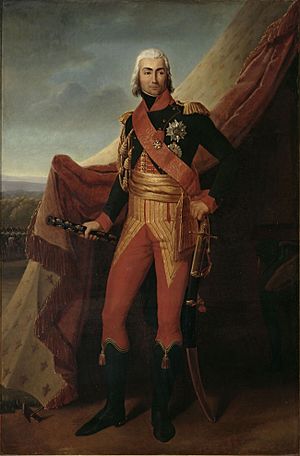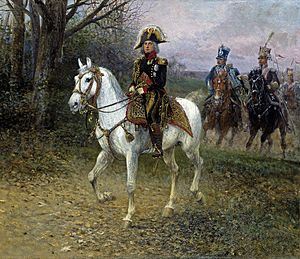Jean-Baptiste Bessières facts for kids
Quick facts for kids
Marshal of the Empire
Jean-Baptiste Bessières
Duke of Istria
|
|
|---|---|

Portrait by Henri-François Riesener
|
|
| Born | 6 August 1768 Prayssac, Kingdom of France |
| Died | 1 May 1813 (aged 44) Weißenfels, Kingdom of Saxony |
| Allegiance | |
| Service/ |
Army |
| Years of service | 1792–1813 |
| Rank | Marshal of the Empire |
| Battles/wars | |
| Awards | Grand Cross of the Legion of Honour Commander of the Order of the Iron Crown Grand Cross of the Order of the Württemberg Crown Grand Cross of the Military Order of St. Henry Grand Cross of the Order of Christ Grand Cross of the Imperial Order of Leopold |
| Relations | Bertrand Bessières (brother) Julien Bessières (cousin) |
| Signature | |
Jean-Baptiste Bessières (born August 6, 1768 – died May 1, 1813) was a brave French military leader. He became a Marshal of the Empire, which was a very high rank. Bessières fought in both the French Revolutionary Wars and the Napoleonic Wars. He was also known as the 1st Duke of Istria. His younger brother, Bertrand Bessières, also became a general. Their cousin, Julien Bessières, worked for Emperor Napoleon I as a diplomat.
Contents
Early Life and His First Steps in the Army
Jean-Baptiste Bessières was born on August 6, 1768, in Prayssac, France. He came from a well-known family. His father, Mathurin Bessières, was a doctor. Jean-Baptiste was the oldest of eight children. He went to school in the nearby city of Cahors.
In 1792, during the French Revolution, Bessières was called to Paris. He joined the King's Constitutional Guard, which was a special group of soldiers protecting King Louis XVI. Each area of France had to send young men to join this guard. Other famous people like Joachim Murat also joined from Bessières' home area.
The Constitutional Guard was not popular with the revolutionaries. It was shut down in May 1792. Bessières then helped defend the Tuileries Palace during a big uprising on August 10. After this, he had to hide for a few months.
Fighting in the Revolutionary Wars
Bessières started his military career again in November 1792. He joined the French Revolutionary Army as a simple cavalryman. Cavalrymen are soldiers who fight on horseback. He joined the 22nd regiment of chasseurs à cheval, which means "hunters on horseback."
For the next three years, Bessières fought in the War of the Pyrenees against Spain. His regiment fought in areas like Catalonia. He was promoted to sub-lieutenant in February 1793.
In 1794, France won a big victory against Spain at the Battle of Boulou. Bessières' cavalry charge was very important in this battle. He also fought bravely at the Battle of the Black Mountain and at Bascara in 1795.
In 1796, Bessières was a captain. He joined Napoleon Bonaparte's army in Italy. His actions at Rovereto caught Napoleon's attention. After the Battle of Rivoli, he was chosen to take captured flags back to France. He quickly returned to the front lines. He commanded a special group called the Guides, who later became the start of Napoleon's famous Imperial Guard.
Bessières then joined Napoleon's expedition to Egypt. He showed great courage at the Siege of Acre and the Battle of Abukir. When he returned to Europe with Napoleon, he was second-in-command of the Consular Guard at the Battle of Marengo in 1800. At the end of this battle, Bessières led a successful cavalry charge.
Leading in the Napoleonic Wars
In 1802, Bessières was promoted to general of division. In 1804, he became a Marshal of the Empire. This was a great honor, partly because he was very loyal to Napoleon. He also became the colonel-general of the Guard Cavalry. He led them in many battles and proved to be a very skilled cavalry commander.
In 1805, Bessières received the Grand Eagle of the Legion of Honour, a very important award. In 1809, Napoleon made him the Duke of Istria. This was a special title that could be passed down in his family.
In 1808, Bessières got his first chance to lead an army on his own during the Peninsular War in Spain. He won a big victory at the Battle of Medina del Rio Seco. However, he was sometimes slow to make decisions when leading a large army. So, Napoleon soon called him back to lead the Guard Cavalry, which was what he did best.
In 1809, war broke out against Austria. Bessières again led the cavalry for Napoleon's main army. At the Battle of Aspern-Essling, he bravely held the center of the battle against many enemies. At the Battle of Wagram, his horse was shot from under him, which worried his soldiers. Napoleon joked that he made his Guard cry but also told him he should have captured more prisoners.
Later that year, Bessières successfully pushed back the British army in the Walcheren Campaign. In 1811, he went back to Spain to lead an army again. He mostly fought against local uprisings. He was recalled to his usual role as the Guard Cavalry commander.
For the Russian campaign in 1812, Bessières commanded the large Guard Cavalry. At the Battle of Borodino, he advised Napoleon not to use the Imperial Guard for a final attack. This decision kept the Guard safe for future battles, but some thought it stopped Napoleon from winning a complete victory in Russia.
In 1813, Bessières was put in charge of all of Napoleon's cavalry.
His Death
Just three days after the start of a new campaign, and the day before the Battle of Lützen, Bessières was killed. He was checking the area near Poserna-Rippach when a cannonball hit a wall and then hit him in the chest. He died right away. Napoleon was very sad to lose one of his truest friends. Other marshals thought he had a good death for a soldier.
After his death, it was found that Bessières had spent a lot of money and was in debt. Napoleon helped his family by paying off most of his debts and looking after his children. His oldest son, Napoléon Bessières, later became a member of a special council under King Louis XVIII.
His Legacy and What He Was Like
As a commander, Bessières was not always the best at leading entire armies. He had mostly commanded Napoleon's personal guard, so he didn't have as much experience leading large forces as some other marshals. However, like Marshal Joachim Murat, he was an excellent cavalry commander. He was also very good at managing the Imperial Guard.
Bessières was not born into a noble family, but he acted like a true gentleman. He often wore the uniform of Napoleon's old Guides and kept his hair long and powdered, even when that style was no longer popular. He was known for being polite, kind, and generous to the soldiers under him.
See also
 In Spanish: Jean-Baptiste Bessières para niños
In Spanish: Jean-Baptiste Bessières para niños


